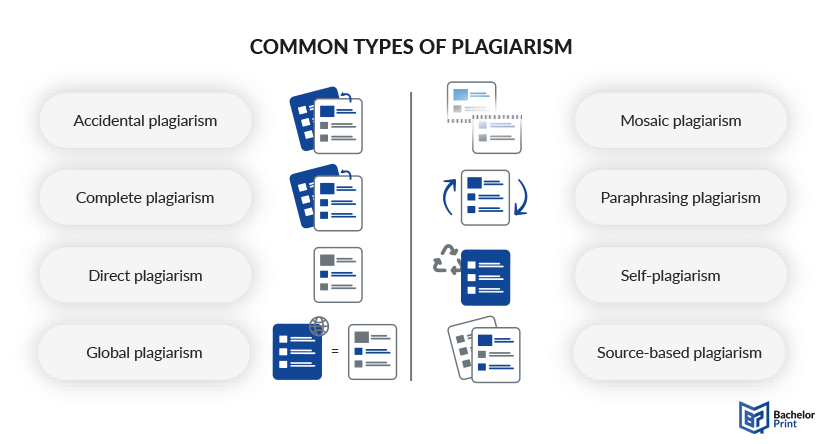
Plagiarism is the act of claiming someone else’s ideas or words as one’s own without giving them credit. It’s a serious issue in schools, publishing, and professional settings as it undermines academic values and ethical standards. Plagiarism can take many subtle and complex forms that are not always easy to recognize. In this article, we’ll delve into the different types of plagiarism along with examples for each one.
Inhaltsverzeichnis
Overview
Plagiarism doesn’t always equal copying an entire paragraph word-for-word, and it can happen in any kid of creative or academic field. Here is a quick overview of the most common types of plagiarism before we dive into each one.
| Accidental plagiarism | Writer misquotes or forgets to cite sources properly. |
| Complete plagiarism | Writer presents someone else’s entire work as their own. |
| Direct plagiarism | Writer directly copies sections without citation. |
| Global plagiarism | Writer copies someone else’s entire work from a broader source. |
| Mosaic plagiarism | Writer combines ideas or phrases from multiple sources without credit. |
| Paraphrasing plagiarism | Writer rewords someone else’s ideas without citation. |
| Patchwork plagiarism | Another term for mosaic plagiarism. |
| Self-plagiarism | Writer recycles their own work or ideas without permission. |
| Source-based plagiarism | Writer uses a secondary source, but only references the primary one. |
in Your Thesis
Examples & explanations
Now that we know the most common types of plagiarism, let’s dive in deeper by explaining each one and giving relevant examples.
Accidental plagiarism happens when someone unintentionally fails to cite a source, misquotes, or paraphrases a source too closely without meaning to cheat. This typically results from not fully understanding citation rules.
Complete plagiarism occurs when someone takes an entire work created by someone else — this could be an article, essay, project, drawing, etc. — and submits it as their own, with no changes.
When someone gets accused of direct plagiarism (also: verbatim plagiarism), it means that they copied someone else’s work word-for-word without quotation marks or any credit to the original source.
Global plagiarism is the most serious type of plagiarism as it means taking an entire work from a broader source (like a published paper, an online essay, or another student’s work) and submitting it as one’s own work. Complete plagiarism and global plagiarism can be used interchangeably, although global plagiarism copies a work across contexts.
Mosaic plagiarism is also known as patchwork plagiarism. This type of plagiarism describes someone interweaving phrases from multiple sources into their own writing without properly crediting them. This type often blends copied and original content.
Paraphrasing plagiarism occurs when someone rewrites someone else’s ideas in their own words but fails to cite the original source.
Self-plagiarism happens when a person reuses their own previously submitted work without permission or without citing that it’s been used before.
Source-based plagiarism involved either citing incorrect sources, making up sources that don’t exist, or improperly citing a secondary source as if it were the original.

Is AI plagiarism?
Yes, using chatbots like ChatGPT and Gemini to complete your assignments and look for existing content online is considered plagiarism, or at best, “ghost-writing.” These AI tools analyze content on the internet and paraphrase it, often using similar wording, which typically makes them detectable by AI detectors. Unlike human-written text, AI content can sound robotic and unnatural a lot of the time. While AI detectors aren’t always correct, even text that doesn’t get flagged may sound off to professors and readers.
When it comes to ethical standards, many people claim that AI technology is not ethical since you are publicly presenting text (or images) as your own creation. This means you are taking someone else’s credit that the machine rewrote by collecting a number of data without consent. To find out about the consequences of plagiarism, check out our article by clicking on the button below.
How to avoid plagiarism
Plagiarism can have serious consequences, as mentioned earlier, so it is important to understand the guidelines for correctly citing sources. Here are a few key strategies to make sure that your work is plagiarism-free.
- Plan your work early: Start your writing process well in advance to give yourself time to organize your thoughts and avoid the temptation or accidental use of copying content at the last minute due to panic.
- Note-taking on your draft: When drafting your paper, make sure to carefully label your own ideas and those from others, e.g., by adding “ME” or “SOURCE” in parentheses after each idea, which you can later remove when proofreading.
- Understand common knowledge: Information that is widely known and accessible from multiple sources does not require citation. So, be careful to distinguish between common knowledge and information that should be credited.
- Labeling direct quotations: Always use quotation marks when including a direct quote and provide the appropriate citation. This, of course, helps readers identify the source of the quoted material clearly.
- Paraphrase & summarize in a new way: When you paraphrase or summarize someone else’s work, make sure to use your own words while still retaining the original meaning, and always properly credit the original author.
- Understand copyright laws: Familiarize yourself with what is protected under copyright and ensure that you don’t use it without obtaining permission or proper attribution, unless it falls under fair use.
- Maintain the same citation style: Seems like an obvious strategy, but especially under pressure, using the wrong citation style required by your institution (APA, MLA, or Chicago style) can unintentionally happen, so make sure to double-check.
- Plagiarism checkers & proofreading: Use online plagiarism detection tools to double-check your work for unintentional similarities with other sources and proofread your work yourself to add an extra layer of protection.
For a more thorough explanation on how to avoid plagiarism, click on the button below.
FAQs
Common types of plagiarism include:
- Paraphrasing plagiarism (Rewording without citation)
- Global plagiarism (Copying an entire text from the internet)
- Mosaic plagiarism (Combining ideas from multiple sources without proper citation)
- Self-plagiarism (Reusing your previous work without permission)
Yes and no. Using ChatGPT is not considered plagiarism if you integrate the information it generates into your work and cite it appropriately. However, if you present ChatGPT’s output without credit, it may be considered plagiarism or ghost-writing.
Yes, reusing your previous work without proper citation or permission can be considered self-plagiarism, particularly in academic settings. So, always check the guidelines on self-citation if you need to reuse your own work.
Paraphrasing is not considered plagiarism as long as you significantly change the wording of the original text and give proper credit to the original author. However, if your paraphrase is too similar to the original without citation, it may still be seen as plagiarism.